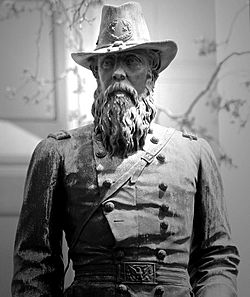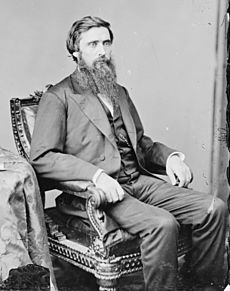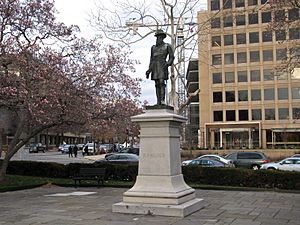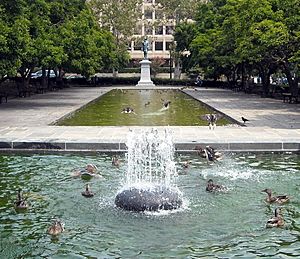Statue of John Aaron Rawlins facts for kids

The sculpture in 2007
|
|
| Coordinates | 38°53′45″N 77°02′31″W / 38.895833°N 77.041944°W |
|---|---|
|
Statue of John Aaron Rawlins
|
|
|
U.S. Historic district
Contributing property |
|
| Part of | Civil War Monuments in Washington, D.C. |
| NRHP reference No. | 78000257 |
| Added to NRHP | September 20, 1978 |
| Location | Rawlins Park, Washington, D.C., United States |
| Designer | Joseph A. Bailly (sculptor) Robert Wood & Company (founder) Westham Granite Works (fabricator) |
| Material | Bronze (sculpture) Granite (base) |
| Width | 4 feet (1.2 m) |
| Height | 20 feet (6.1 m) |
| Opening date | 1874 |
| Dedicated to | John Aaron Rawlins |
The statue of John Aaron Rawlins stands in Rawlins Park in Washington, D.C.. John Aaron Rawlins was an important general in the United States Army during the Civil War. After the war, he became the Secretary of War. This statue was put in place in 1874. It was moved several times between 1880 and 1931 before returning to Rawlins Park.
The statue was created by Joseph A. Bailly, a French-American artist. His most famous work is the statue of George Washington in Philadelphia. The statue is made of bronze and sits on a strong granite base. It is one of many Civil War monuments in Washington, D.C. These monuments were all added to the National Register of Historic Places in 1978. The National Park Service takes care of the statue and the park. Many historians think this statue is one of the best portrait statues in the city.
Contents
Who Was John Aaron Rawlins?
Early Life and Military Career
John Aaron Rawlins (1831–1869) was a lawyer from Illinois. He helped create the 45th Illinois Infantry for the Union Army. This was during the Civil War. Rawlins became a very close friend and advisor to General Ulysses S. Grant. He stayed by Grant's side throughout the war.
Serving as Secretary of War
After Grant became president, Rawlins served as his Secretary of War. Sadly, Rawlins died from an illness just five months into his job. During his time as Secretary, Rawlins cared deeply about recently freed slaves. He also tried to protect Native Americans from unfair treatment. He was known for speaking his mind and protecting Grant from bad influences.
Building the Rawlins Statue
Planning the Monument
People wanted to honor Rawlins with a statue soon after he died in 1869. Interest in the project slowed down for a while. Then, in 1872, President Grant wrote a letter to Congress. He asked them to move forward with the statue. Congress approved $10,000 for the statue on June 10, 1872.
A special committee was formed to choose an artist. The committee included General Orville E. Babcock and other important people. They looked at designs from several sculptors. They finally chose Joseph A. Bailly. Bailly was a French-born American sculptor. He was famous for his statue of George Washington in Philadelphia.
Creating the Sculpture
The statue was made by Robert Wood & Company. The bronze used for the statue came from Confederate cannons. These cannons were captured during the Civil War. This made the statue even more special. The total cost for the statue and its setup was $13,000.
The statue was first planned for Franklin Square. However, it was placed in Rawlins Park in November 1874. Rawlins Park was a small, quiet area at the time. There was no big ceremony when the statue was put up. The next year, a granite base was added to the statue. This base was built by the Westham Granite Company.
The Statue's Journey and Park Improvements
Moving the Statue Around Town
In 1880, a group called the Grand Army of the Republic visited the statue. They were not happy with the park's condition. They asked for the statue to be moved to a better spot. It was moved to 10th and D Streets NW. Later, it moved again to Pennsylvania Avenue.
In 1886, a public restroom was built where the statue stood. So, it was moved across the street. Finally, in 1931, the statue was moved back to its original home in Rawlins Park. This was its last move.
Rawlins Park Today
Rawlins Park itself was greatly improved in 1938. New walkways were added, along with a beautiful reflecting pool. In 1963, a politician from Wyoming tried to move the statue to Rawlins. This town was named after the general. But the statue stayed in Washington, D.C.
The Rawlins statue is one of eighteen Civil War monuments in Washington, D.C. It was officially listed on the National Register of Historic Places in 1978. It's special because it's not an equestrian sculpture (a statue of someone on a horse). The National Park Service continues to care for the statue and the park. Many experts believe it's a very elegant and spirited statue.
Design and Location of the Statue
The statue is located on the eastern side of Rawlins Park. This park is in the Foggy Bottom neighborhood of Washington, D.C. It's near several important buildings. These include the Main Interior Building and the United States General Services Administration Building.
The bronze statue itself is about 8 feet (2.4 meters) tall. Its light gray granite base is about 12 feet (3.7 meters) high and 4 feet (1.2 meters) wide. The statue shows Rawlins standing in his Civil War military uniform. He wears a hat, a long jacket, tall boots, and gloves. His left leg is slightly forward. He holds field glasses in his right hand. His left hand rests on his sword handle. Rawlins is shown with a beard and mustache.
The word "RAWLINS" is carved on the front of the base. Other carvings on the sculpture show who made it. These include "R. WOOD & CO / BRONZE FOUNDERS / PHILA" and "A. BAILLY, sculpt / 1873".
See also
 In Spanish: Estatua de John Aaron Rawlins para niños
In Spanish: Estatua de John Aaron Rawlins para niños




